Javier Hernandez-Ortega
FaceQgen: Semi-Supervised Deep Learning for Face Image Quality Assessment
Jan 03, 2022



Abstract:In this paper we develop FaceQgen, a No-Reference Quality Assessment approach for face images based on a Generative Adversarial Network that generates a scalar quality measure related with the face recognition accuracy. FaceQgen does not require labelled quality measures for training. It is trained from scratch using the SCface database. FaceQgen applies image restoration to a face image of unknown quality, transforming it into a canonical high quality image, i.e., frontal pose, homogeneous background, etc. The quality estimation is built as the similarity between the original and the restored images, since low quality images experience bigger changes due to restoration. We compare three different numerical quality measures: a) the MSE between the original and the restored images, b) their SSIM, and c) the output score of the Discriminator of the GAN. The results demonstrate that FaceQgen's quality measures are good estimators of face recognition accuracy. Our experiments include a comparison with other quality assessment methods designed for faces and for general images, in order to position FaceQgen in the state of the art. This comparison shows that, even though FaceQgen does not surpass the best existing face quality assessment methods in terms of face recognition accuracy prediction, it achieves good enough results to demonstrate the potential of semi-supervised learning approaches for quality estimation (in particular, data-driven learning based on a single high quality image per subject), having the capacity to improve its performance in the future with adequate refinement of the model and the significant advantage over competing methods of not needing quality labels for its development. This makes FaceQgen flexible and scalable without expensive data curation.
Introduction to Presentation Attack Detection in Face Biometrics and Recent Advances
Nov 26, 2021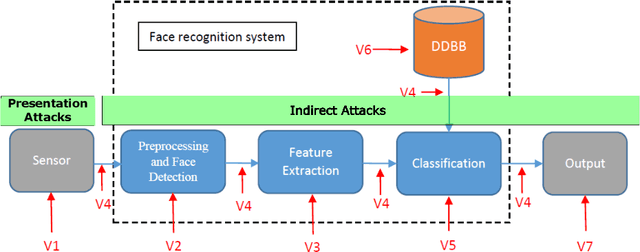
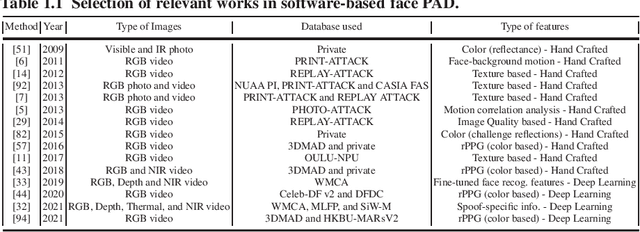
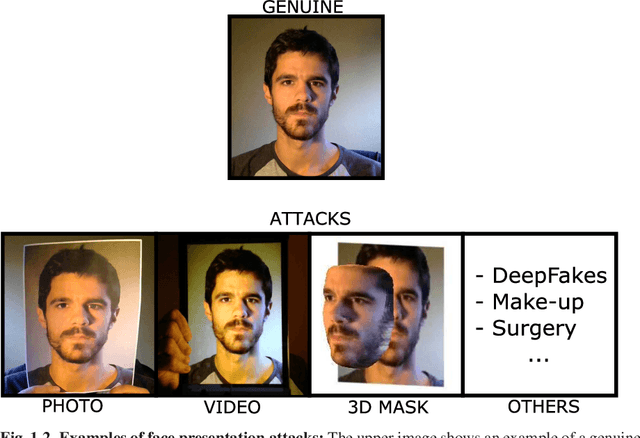

Abstract:The main scope of this chapter is to serve as an introduction to face presentation attack detection, including key resources and advances in the field in the last few years. The next pages present the different presentation attacks that a face recognition system can confront, in which an attacker presents to the sensor, mainly a camera, a Presentation Attack Instrument (PAI), that is generally a photograph, a video, or a mask, to try to impersonate a genuine user. First, we make an introduction of the current status of face recognition, its level of deployment, and its challenges. In addition, we present the vulnerabilities and the possible attacks that a face recognition system may be exposed to, showing that way the high importance of presentation attack detection methods. We review different types of presentation attack methods, from simpler to more complex ones, and in which cases they could be effective. Then, we summarize the most popular presentation attack detection methods to deal with these attacks. Finally, we introduce public datasets used by the research community for exploring vulnerabilities of face biometrics to presentation attacks and developing effective countermeasures against known PAIs.
FaceQvec: Vector Quality Assessment for Face Biometrics based on ISO Compliance
Nov 03, 2021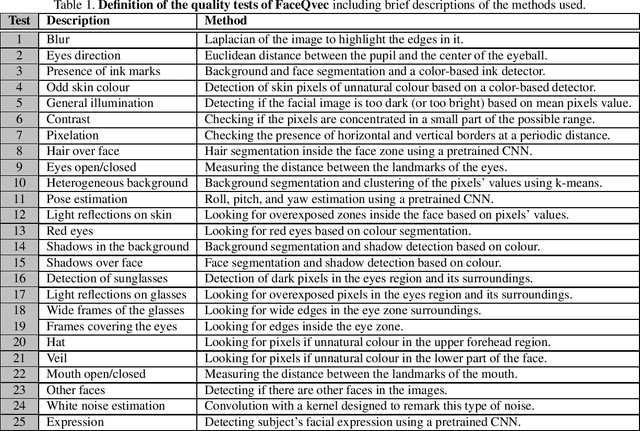
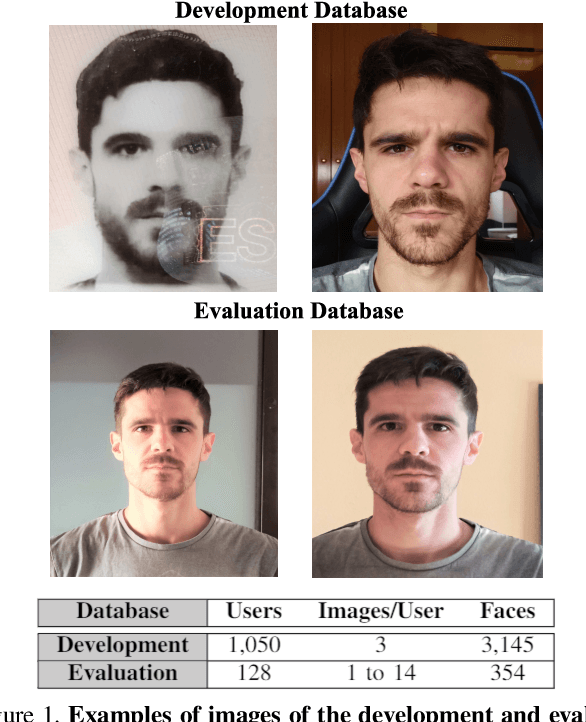
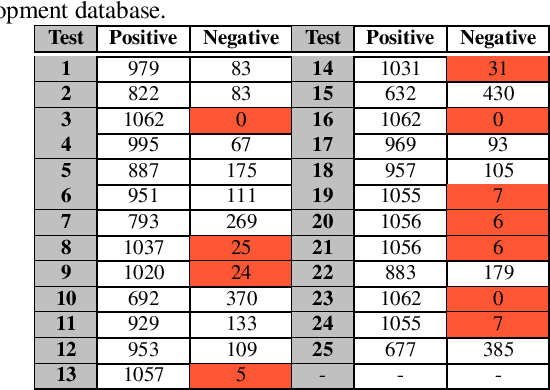
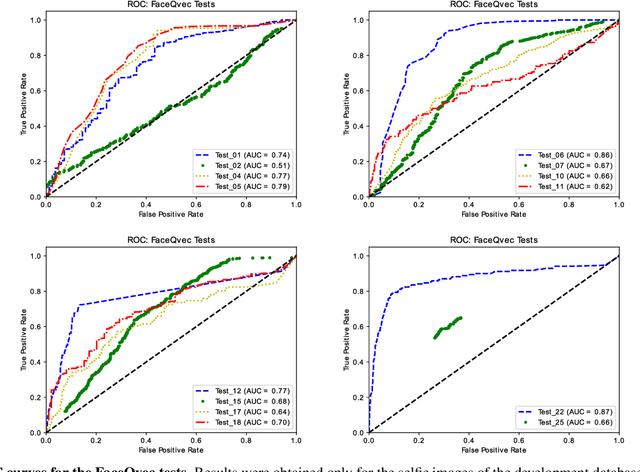
Abstract:In this paper we develop FaceQvec, a software component for estimating the conformity of facial images with each of the points contemplated in the ISO/IEC 19794-5, a quality standard that defines general quality guidelines for face images that would make them acceptable or unacceptable for use in official documents such as passports or ID cards. This type of tool for quality assessment can help to improve the accuracy of face recognition, as well as to identify which factors are affecting the quality of a given face image and to take actions to eliminate or reduce those factors, e.g., with postprocessing techniques or re-acquisition of the image. FaceQvec consists of the automation of 25 individual tests related to different points contemplated in the aforementioned standard, as well as other characteristics of the images that have been considered to be related to facial quality. We first include the results of the quality tests evaluated on a development dataset captured under realistic conditions. We used those results to adjust the decision threshold of each test. Then we checked again their accuracy on a evaluation database that contains new face images not seen during development. The evaluation results demonstrate the accuracy of the individual tests for checking compliance with ISO/IEC 19794-5. FaceQvec is available online (https://github.com/uam-biometrics/FaceQvec).
DeepFakesON-Phys: DeepFakes Detection based on Heart Rate Estimation
Oct 06, 2020


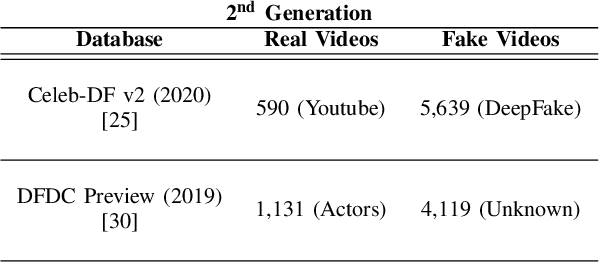
Abstract:This work introduces a novel DeepFake detection framework based on physiological measurement. In particular, we consider information related to the heart rate using remote photoplethysmography (rPPG). rPPG methods analyze video sequences looking for subtle color changes in the human skin, revealing the presence of human blood under the tissues. In this work we investigate to what extent rPPG is useful for the detection of DeepFake videos. The proposed fake detector named DeepFakesON-Phys uses a Convolutional Attention Network (CAN), which extracts spatial and temporal information from video frames, analyzing and combining both sources to better detect fake videos. This detection approach has been experimentally evaluated using the latest public databases in the field: Celeb-DF and DFDC. The results achieved, above 98% AUC (Area Under the Curve) on both databases, outperform the state of the art and prove the success of fake detectors based on physiological measurement to detect the latest DeepFake videos.
Biometric Quality: Review and Application to Face Recognition with FaceQnet
Jun 18, 2020



Abstract:"The output of a computerised system can only be as accurate as the information entered into it." This rather trivial statement is the basis behind one of the driving concepts in biometric recognition: biometric quality. Quality is nowadays widely regarded as the number one factor responsible for the good or bad performance of automated biometric systems. It refers to the ability of a biometric sample to be used for recognition purposes and produce consistent, accurate, and reliable results. Such a subjective term is objectively estimated by the so-called biometric quality metrics. These algorithms play nowadays a pivotal role in the correct functioning of systems, providing feedback to the users and working as invaluable audit tools. In spite of their unanimously accepted relevance, some of the most used and deployed biometric characteristics are lacking behind in the development of these methods. This is the case of face recognition. After a gentle introduction to the general topic of biometric quality and a review of past efforts in face quality metrics, in the present work, we address the need for better face quality metrics by developing FaceQnet. FaceQnet is a novel opensource face quality assessment tool, inspired and powered by deep learning technology, which assigns a scalar quality measure to facial images, as prediction of their recognition accuracy. Two versions of FaceQnet have been thoroughly evaluated both in this work and also independently by NIST, showing the soundness of the approach and its competitiveness with respect to current state-of-the-art metrics. Even though our work is presented here particularly in the framework of face biometrics, the proposed methodology for building a fully automated quality metric can be very useful and easily adapted to other artificial intelligence tasks.
Heart Rate Estimation from Face Videos for Student Assessment: Experiments on edBB
Jun 01, 2020



Abstract:In this study we estimate the heart rate from face videos for student assessment. This information could be very valuable to track their status along time and also to estimate other data such as their attention level or the presence of stress that may be caused by cheating attempts. The recent edBBplat, a platform for student behavior modelling in remote education, is considered in this study1. This platform permits to capture several signals from a set of sensors that capture biometric and behavioral data: RGB and near infrared cameras, microphone, EEG band, mouse, smartwatch, and keyboard, among others. In the experimental framework of this study, we focus on the RGB and near-infrared video sequences for performing heart rate estimation applying remote photoplethysmography techniques. The experiments include behavioral and physiological data from 25 different students completing a collection of tasks related to e-learning. Our proposed face heart rate estimation approach is compared with the heart rate provided by the smartwatch, achieving very promising results for its future deployment in e-learning applications.
A Comparative Evaluation of Heart Rate Estimation Methods using Face Videos
May 22, 2020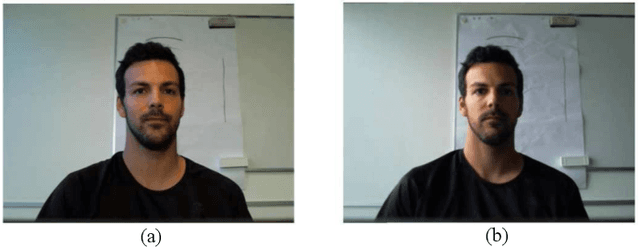

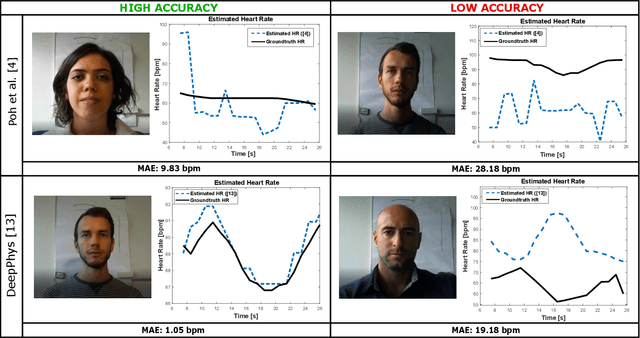

Abstract:This paper presents a comparative evaluation of methods for remote heart rate estimation using face videos, i.e., given a video sequence of the face as input, methods to process it to obtain a robust estimation of the subjects heart rate at each moment. Four alternatives from the literature are tested, three based in hand crafted approaches and one based on deep learning. The methods are compared using RGB videos from the COHFACE database. Experiments show that the learning-based method achieves much better accuracy than the hand crafted ones. The low error rate achieved by the learning based model makes possible its application in real scenarios, e.g. in medical or sports environments.
edBB: Biometrics and Behavior for Assessing Remote Education
Dec 10, 2019

Abstract:We present a platform for student monitoring in remote education consisting of a collection of sensors and software that capture biometric and behavioral data. We define a collection of tasks to acquire behavioral data that can be useful for facing the existing challenges in automatic student monitoring during remote evaluation. Additionally, we release an initial database including data from 20 different users completing these tasks with a set of basic sensors: webcam, microphone, mouse, and keyboard; and also from more advanced sensors: NIR camera, smartwatch, additional RGB cameras, and an EEG band. Information from the computer (e.g. system logs, MAC, IP, or web browsing history) is also stored. During each acquisition session each user completed three different types of tasks generating data of different nature: mouse and keystroke dynamics, face data, and audio data among others. The tasks have been designed with two main goals in mind: i) analyse the capacity of such biometric and behavioral data for detecting anomalies during remote evaluation, and ii) study the capability of these data, i.e. EEG, ECG, or NIR video, for estimating other information about the users such as their attention level, the presence of stress, or their pulse rate.
Quality-based Pulse Estimation from NIR Face Video with Application to Driver Monitoring
May 20, 2019



Abstract:In this paper we develop a robust for heart rate (HR) estimation method using face video for challenging scenarios with high variability sources such as head movement, illumination changes, vibration, blur, etc. Our method employs a quality measure Q to extract a remote Plethysmography (rPPG) signal as clean as possible from a specific face video segment. Our main motivation is developing robust technology for driver monitoring. Therefore, for our experiments we use a self-collected dataset consisting of Near Infrared (NIR) videos acquired with a camera mounted in the dashboard of a real moving car. We compare the performance of a classic rPPG algorithm, and the performance of the same method, but using Q for selecting which video segments present a lower amount of variability. Our results show that using the video segments with the highest quality in a realistic driving setup improves the HR estimation with a relative accuracy improvement larger than 20%.
FaceQnet: Quality Assessment for Face Recognition based on Deep Learning
Apr 04, 2019



Abstract:In this paper we develop a Quality Assessment approach for face recognition based on deep learning. The method consists of a Convolutional Neural Network, FaceQnet, that is used to predict the suitability of a specific input image for face recognition purposes. The training of FaceQnet is done using the VGGFace2 database. We employ the BioLab-ICAO framework for labeling the VGGFace2 images with quality information related to their ICAO compliance level. The groundtruth quality labels are obtained using FaceNet to generate comparison scores. We employ the groundtruth data to fine-tune a ResNet-based CNN, making it capable of returning a numerical quality measure for each input image. Finally, we verify if the FaceQnet scores are suitable to predict the expected performance when employing a specific image for face recognition with a COTS face recognition system. Several conclusions can be drawn from this work, most notably: 1) we managed to employ an existing ICAO compliance framework and a pretrained CNN to automatically label data with quality information, 2) we trained FaceQnet for quality estimation by fine-tuning a pre-trained face recognition network (ResNet-50), and 3) we have shown that the predictions from FaceQnet are highly correlated with the face recognition accuracy of a state-of-the-art commercial system not used during development. FaceQnet is publicly available in GitHub.
 Add to Chrome
Add to Chrome Add to Firefox
Add to Firefox Add to Edge
Add to Edge